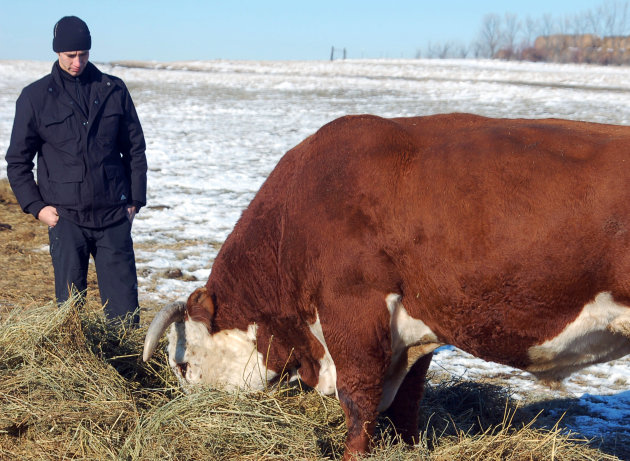
Mananbai Sadykov cuffed his stiff blue jeans over intricately stitched cowboy boots and tread mindfully though minefields of cattle manure at the Helbling Hereford Ranch in central North Dakota.
Sadykov, 48, is no citified dandy, having worked with livestock most of his life in Kazakhstan.
But he tried to keep his new duds — a gift from some North Dakota
ranchers — cowpie-free. Western wear is rare in the former Soviet
republic. And, until recently, so were cows.
About 15 Kazakh cattlemen, Sadykov
included, visited North Dakota ranches in November to inspect the
state's beef herd and get a hands-on tutorial in tending cattle from
veteran cowboys.
"It's not splitting atoms growing cows. But it is hard work," said
Mark Archibald, who ranches near Hettinger in southwest North Dakota and
hosted a contingent of the Kazakhs. "They haven't had the background to
build upon so we're showing them our way of doing things."Kazakhstan's beef herd was butchered and all but sold off following the downfall of the Soviet Union in 1991. Cattle numbers dropped from about 35 million to about 2 million. To help rebuild that industry, more than 5,000 Hereford and Angus cattle bred to withstand North Dakota's notoriously nasty winters have been sent since 2010 via jumbo jets from Fargo to Kazakhstan, and a shipment of 3,000 more is planned before year's end.
Sadykov has been overseeing several hundred of the relocated ruminants in Kazakhstan, whose climate and landscape are similar to North Dakota's.
"Very good, very tough cows,"
Sadykov said through an interpreter, while eyeing dozens of hardy
Herefords with their thick, hairy coats. "Very good in cold."
North Dakota's cows also typically have more marbling and fatty
tissue, which gives the state an advantage in cattle sales, agriculture
officials said.
"There are some marketing opportunities there," said Agriculture Commissioner Doug Goehring, "It's going to take a long time for them to build up their inventory."
Dean Gorder, executive director of the North Dakota Trade Office, said the state has had a strong trade relationship with Kazakhstan and also exports farm machinery.
Gorder and Goehring both have made several visits to Kazakhstan, a
million-square-mile landmass that stretches from central Asia to eastern
Europe. The largely Muslim country's appetite for beef also is big,
Goehring said."It's a country that consumes large amounts of meat," he said. "I watch those guys eat and I get a bellyache."
Daulet Chunkunov, a Kazakh trade representative, said the oil-rich nation currently buys the bulk of its processed beef from Europe and Australia but is prepared to spend billions building up its own cattle industry, which could take decades. The Kazakh government paid for the cattlemen's trip to North Dakota.
"We have oil money, a strong domestic market, support of the government and a labor force," Chunkunov said.
Cattle ranching also appeals to many young people in Kazakhstan, Chunkunov said. Several Kazakh cattlemen in their 20s were among those touring North Dakota ranches, getting tips on everything from bovine nutrition and branding to vaccinations and bull castrations.
"I like being a cowboy," said
Viktor Kapinus, a tall, wiry 21-year-old who recently started working at
a rural ranch well outside of his hometown of Astana in central
Kazakhstan.
Kapinus, already comfortable
around cows, fearlessly approached and petted a more than 2,000-pound
Hereford bull grazing on hay, while of his less-bold sidekicks snapped
pictures.
Fred Helbling,
who owns the ranch with his brothers, Wayne and Jim, said the Kazakhs
may not dress like typical North Dakota cowboys but many are master
horsemen who have taken quickly to cows.
"You can't judge a book by its
cover," said Fred Helbling, whose great-grandfather emigrated from
Russia and homesteaded the sprawling ranch almost a century ago.
Jim Hebling added, "They do have a lot of passion."
Dauletgali Zhaitapov, 24, said
his family owns hundreds of horses but only recently expanded into cows,
many of which have come from North Dakota. Zhaitapov said he recently
participated in a big cattle drive in his country, something he'd only
seen before in "John Wayne movies."
"I was like the Marlboro man," he said.

No comments:
Post a Comment